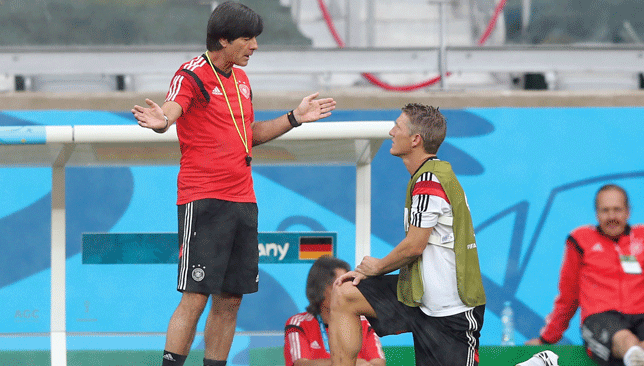
Billed as the collective versus the individual. The gritty, determined Argentina against the free-flowing pace and precision of Germany or, more simply, Europe versus South America, tonight’s final is a pleasant mixture of styles.
In terms of the managers, Joachim Low is the suave, debonair image of a modern coach, Alejandro Sabella – only five years his senior – the more rugged, straightforward man who takes a pragmatic approach to the game.
Each will be looking to outwit the other through their selections, strategies and influence on the match.
Here are the four key tactical issues going into the match.
Stopping Messi
Using the template set by Belgium and the Netherlands, the way to prevent Messi from running the show is to hold a deep defensive line throughout, not commit too many men forward and ultimately ensure there is no space in the final third for him to run into.
In the quarter and semi-final neither side wanted to take the risk of attacking, such is the clinical nature of Messi’s attacking abilities, either through scoring or making goals.
The issue for Germany is that tactic goes against how they’ve been playing this entire tournament. Low favours a high pressing line with Manuel Neuer (witnessed repeatedly against Algeria) coming out of goal to sweep up.
That could play into Argentina’s hands, so Low could drop deep and adopt a more counter-attacking mentality or assign one of Bastian Schweinsteiger or Sami Khedira to man mark Messi. Schweinsteiger’s defensive game is underrated but the concern is Messi drifting too wide, dragging the German out of position and leaving holes in the midfield for others to exploit.
Restricting German fluidity
Three clean sheets in 330 minutes of knockout matches displays an Argentine defence in fantastic form. When you factor in that against Switzerland, Begium and the Dutch they conceded just six shots on target, it is a well-organised unit that will take some unlocking. As stated previously, Messi plays a significant role in that; the opposition are fearful of committing too many men forward.
However, with the exception of Arjen Robben, none of Argentina’s three previous opponents have attacking capabilities with the depth of Germany’s.
Assuming Low selects Thomas Muller, Miroslav Klose and Mesut Ozil (his preferred trio against France and Brazil) La Albiceleste will have to deal with the width and movement of Muller, the finishing and penalty box play of Klose and Ozil’s ability to drift between the lines.
In reserve he also has Andre Schurrle – the one true exponent of pace in the German frontline – and Mario Gotze, a skillful, right-sided Ozil-like player.
Based on Low’s comments last night, they are going to try to be pro-active, rather than reactive to Argentina’s play. We should then all see just how good this Argentina defence really is.
The battle for possession
In terms of possession, Germany (59.4 per cent) and Argentina (58.5 per cent) are second and fourth in the World Cup. Regarding average passes they’re also second (Germany – 635) and fourth (Argentina – 555), while in pass completition they’re third (Germany – 86.4 per cent) and fourth (Argentina – 85.9 per cent).
In short: both teams like to have the ball.
At South Africa in 2010 (with nine of Low’s likely starting XI also at that tournament) Die Mannschaft were a strict counter-attacking outfit but that has changed over the four years and they now like to dictate the pace of the game.
Argentina are no different and Javier Mascherano, Lucas Biglia and Enzo Perez or Angel Di Maria will be demanding the ball from Schweinsteiger, Khedira and Toni Kroos.
Argentina, especially in the case of Mascherano, perhaps have the better ball-winners but Germany like to press and restrict, and much of the pain they inflicted on Brazil was down to stealing possession in the opposition half.
Utilising bench strength
How each manager has used substitutes over the tournament makes for an interesting comparison. Both Low and Alejandro Sabella have used three in all six of their matches but it is the German who has got the best out of his bench so far.
Sabella’s best move came in the opening game against Bosnia & Herzegovina, where the introduction of Gonzalo Higuain and Fernando Gago at half-time helped them turn around an uncertain first 45 minutes.
Of Germany’s 17 goals, four have been scored by replacements (none of Argentina’s eight have) with Schurrle on three (one short of Roger Milla’s World Cup record) and Klose one.
However, while this should be an advantage, what Sabella does have over Low is that he has replacements to help Argentina conserve a lead in Gago and Enzo Perez, as well as those who can chase the game in Rodrigo Palacio, Maxi Rodriguez and Ricky Alvarez.
Low’s main options are all essentially attacking ones, in Schurrle, Gotze, Lukas Podolski or Julian Draxler.
Outside of that central holding midfielder Christoph Kramer is inexperienced while defenders Matthias Ginter and Erik Drum and utility man Kevin Grosskreutz are yet to play a minute in Brazil.